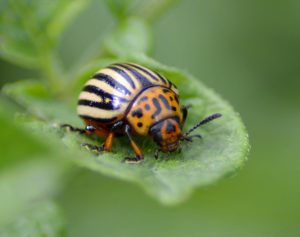
Entomology is the study of insects. This page provides some basic information on insects. First we look at the anatomy of adult insects, and then we will see a short story about the metamorphosis of insects.
Insect anatomy
To learn more about the anatomy, click on the different body parts of this insect !!

Metamorphosis of insects
In their development from egg to adult, insects change in form. The different instars are not alike, which is called metamorphosis. There are two general types of metamorphosis: simple metamorphosis and complete metamorphosis.
Simple metamorphosis
In simple metamorphosis the wings develop externally during the larval stages. The larval stages, which are called nymphs, look very similar to the adult insect. There is no pupal stage.

The figure shows the development from an egg via 5 larval instars to an adult bug.
Complete metamorphosis
In a complete metamorphosis the wings develop internally during the larval stages. The larval stages look quite different from the adult insect. Between the last larval stage and the adult stage there is a pupal stage which usually is inactive.

The figure shows the development from an egg via the larval stage (caterpillar) and pupa to an adult butterfly or moth.
Did you know that?
- The world’s largest insect is a stick insect from Borneo. Including the legs, it is 20 inches (about 50 centimeters) long.
- The heaviest insect in the world is the African goliath beetle. Large goliath beetles can be 4 inches (10 centimeters) long and can weigh a quarter of a pound (110 grams).
- Already about 900,000 species of insects have been found and have received a name, but still many more insect species have to be discovered.
- The fastest insect is the dragonfly. The insects can reach a speed of about 58 km per hour.
- Many people in the world eat insects. In some countries there are farmers who produce insects and sell them as tasty snacks.
- There are several insects that can produce light, for example fireflies. Note that a firefly is not really a fly; it's a beetle.
Learn more about insects
There are many different types of insects. Some are good and some are bad. Click here if you want to learn more about good insects and bad insects.
Insects are tiny creatures in a big world. Perhaps you have wondered how they can find each other? Learn more about how insects can find each other.
There are hundred thousands of different species of insects. How do we keep these insects apart? Learn more about Insect Classification.
For some people insects are beautiful, for others they are just pests who should be killed. Of course, bed bugs are no fun, and a mosquito or wasp can be a nuisance. And you don't want beetles or caterpillars eating the vegetables in your garden. However, if you have problems with insects, don't be an exterminator. Don't think immediately of using toxic insecticides, but try to use safer ways of pest control. Use Integrated Pest Management (IPM) instead of pest control with insecticides. Learn more about Integrated Pest Management.
If you are interested in insects, perhaps you also like spiders? See Araneology for beginners (Araneology is the study about spiders)
For technical terms about insects and spiders, please see the Glossary of Entomology
Note: Many school children and school teachers visit this page to learn about insects. If your school has a website, please link to this page. If you have ideas for similar pages, please send me a message.
